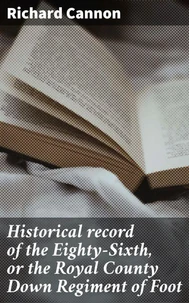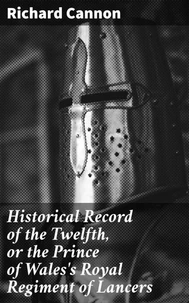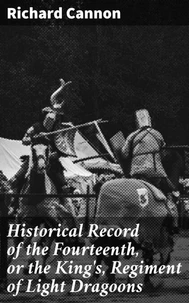Historical Record of the Sixth, or Royal First Warwickshire Regiment of Foot
Par :Formats :
Disponible dans votre compte client Decitre ou Furet du Nord dès validation de votre commande. Le format ePub est :
- Compatible avec une lecture sur My Vivlio (smartphone, tablette, ordinateur)
- Compatible avec une lecture sur liseuses Vivlio
- Pour les liseuses autres que Vivlio, vous devez utiliser le logiciel Adobe Digital Edition. Non compatible avec la lecture sur les liseuses Kindle, Remarkable et Sony
 , qui est-ce ?
, qui est-ce ?Notre partenaire de plateforme de lecture numérique où vous retrouverez l'ensemble de vos ebooks gratuitement
Pour en savoir plus sur nos ebooks, consultez notre aide en ligne ici
- Nombre de pages102
- FormatePub
- ISBN859-65--4737752-8
- EAN8596547377528
- Date de parution16/09/2022
- Protection num.Digital Watermarking
- Taille747 Ko
- Infos supplémentairesepub
- ÉditeurDIGICAT
Résumé
Richard Cannon's "Historical Record of the Sixth, or Royal First Warwickshire Regiment of Foot" is a meticulous account that chronicles the illustrious history of one of Britain's distinguished infantry regiments. Through a blend of detailed narration and a rigorous chronological structure, Cannon examines the regiment's formation, significant battles, and the pivotal role it played in various military campaigns from its inception to the early 19th century.
His writing exudes a sense of reverence, characterized by a balanced prose that harmoniously intertwines factual precision with engaging storytelling, making it both informative and accessible to readers with varying degrees of historical knowledge. Cannon, a prominent military historian and army officer, utilized his extensive background in military affairs to construct this comprehensive record.
His own service and familiarity with military life not only endowed him with credibility but also provided him with rare insights into the experiences of the men who served in the regiment. His dedication to preserving the honor and experiences of soldiers reflects the broader social context of post-Napoleonic Britain, where commemoration of military achievements became increasingly important. This book is an invaluable resource for historians, military enthusiasts, and anyone interested in the rich tapestry of British military history.
Cannon's work serves not only as a record of the regiment's past but also as a tribute to the valor and sacrifice of the soldiers who served. Readers seeking to understand the complexities of military heritage and identity in the British Army will find this narrative both enlightening and compelling.
His writing exudes a sense of reverence, characterized by a balanced prose that harmoniously intertwines factual precision with engaging storytelling, making it both informative and accessible to readers with varying degrees of historical knowledge. Cannon, a prominent military historian and army officer, utilized his extensive background in military affairs to construct this comprehensive record.
His own service and familiarity with military life not only endowed him with credibility but also provided him with rare insights into the experiences of the men who served in the regiment. His dedication to preserving the honor and experiences of soldiers reflects the broader social context of post-Napoleonic Britain, where commemoration of military achievements became increasingly important. This book is an invaluable resource for historians, military enthusiasts, and anyone interested in the rich tapestry of British military history.
Cannon's work serves not only as a record of the regiment's past but also as a tribute to the valor and sacrifice of the soldiers who served. Readers seeking to understand the complexities of military heritage and identity in the British Army will find this narrative both enlightening and compelling.
Richard Cannon's "Historical Record of the Sixth, or Royal First Warwickshire Regiment of Foot" is a meticulous account that chronicles the illustrious history of one of Britain's distinguished infantry regiments. Through a blend of detailed narration and a rigorous chronological structure, Cannon examines the regiment's formation, significant battles, and the pivotal role it played in various military campaigns from its inception to the early 19th century.
His writing exudes a sense of reverence, characterized by a balanced prose that harmoniously intertwines factual precision with engaging storytelling, making it both informative and accessible to readers with varying degrees of historical knowledge. Cannon, a prominent military historian and army officer, utilized his extensive background in military affairs to construct this comprehensive record.
His own service and familiarity with military life not only endowed him with credibility but also provided him with rare insights into the experiences of the men who served in the regiment. His dedication to preserving the honor and experiences of soldiers reflects the broader social context of post-Napoleonic Britain, where commemoration of military achievements became increasingly important. This book is an invaluable resource for historians, military enthusiasts, and anyone interested in the rich tapestry of British military history.
Cannon's work serves not only as a record of the regiment's past but also as a tribute to the valor and sacrifice of the soldiers who served. Readers seeking to understand the complexities of military heritage and identity in the British Army will find this narrative both enlightening and compelling.
His writing exudes a sense of reverence, characterized by a balanced prose that harmoniously intertwines factual precision with engaging storytelling, making it both informative and accessible to readers with varying degrees of historical knowledge. Cannon, a prominent military historian and army officer, utilized his extensive background in military affairs to construct this comprehensive record.
His own service and familiarity with military life not only endowed him with credibility but also provided him with rare insights into the experiences of the men who served in the regiment. His dedication to preserving the honor and experiences of soldiers reflects the broader social context of post-Napoleonic Britain, where commemoration of military achievements became increasingly important. This book is an invaluable resource for historians, military enthusiasts, and anyone interested in the rich tapestry of British military history.
Cannon's work serves not only as a record of the regiment's past but also as a tribute to the valor and sacrifice of the soldiers who served. Readers seeking to understand the complexities of military heritage and identity in the British Army will find this narrative both enlightening and compelling.







